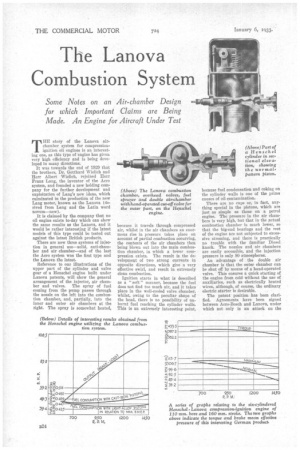The Lanova Combustion System
Page 38

Page 39

If you've noticed an error in this article please click here to report it so we can fix it.
Some Notes on an Air-chamber Design for which Important Claims are Being Made. An Engine for Aircraft Under Test
THE story of the Lanova airchamber system for compressionignition oil engines is an interesting one, as this type of engine has given very high efficiency and is being developed in many directions.
It was towards the end of 1929 that the brothers, Dr. Gotthard Wielich and Herr Albert Wielich, rejoined Herr Franz Lang, the inventor of the Acro system, and founded a new holding company for the further development and exploitation of Lang's new ideas, which culminated in the production of the new Lang motor, known as the Lanova (derived from Lang and the Latin word novum—new).
It is claimed by the company that no oil engine exists to-day which can show the same results as the Lanova, and it would be rather interesting if the latest models of this type could be tested out against the latest British products.
There are now three systems of injection in general use—solid, anti-chamber and air chamber—and of the last the Acro system was the first type and the Lanova the latest.
Reference to our illustrations of the upper part of the cylinder and valve gear of a Henschel engine built under Lanova patents, will show the general arrangement of the injector, air chamber and valves. The spray of fuel coming from the pump passes through the nozzle on the left into the combustion chamber, and, partially, into the inner and outer air chambers at the right. The spray is somewhat heated,
because it travels through compressed air, whilst in the air chambers an enormous rise in pressure takes place on account of partial combustion occurring, the contents of the air chambers then being blown out into the main combustion chamber, in which a lower compression exists. The result is the development of two strong currents in opposite directions, which give a very effective swirl, and result in extremely clean combustion.
Ignition starts in what is described as a " soft " manner, because the fuel does not find too much air, and it takes place in the well-cooled valve chamber, whilst, owing to the peculiar shape of the head, there is no possibility of rimburnt fuel reaching the cylinder walls. This is an extremely interesting point, because fuel condensation and coking on the cylinder walls is one of the prime causes of oil contamination.
There are no cups or, in fact, anything special in the pistons, which are just as simple as those on a petrol engine. The pressure in the air chambers is very high, hut that in the actual combustion chamber is much lower, so that the big-end bearings and the rest of the engine are not subjected to excessive stressing, and there is practically no trouble with the familiar Diesel knock. The nozzles and air chambers are easily accessible, and the injection pressure is only SO atmospheres.
An advantage of the double air chamber is that the outer chamber can be shut off by means of a hand-operated valve. This ensures a quick starting of the engine from cold without the use of auxiliaries, such as electrically heated wires, although, of course, the ordinary electric starter is desirable.
The patent position has been clarified. Agreements have been signed between Acro-Bosch and Lanova, under which not only is an attack on the
LfillOVa patents from Aero-Bosch excluded, but the Lanova concern has received important rights in respect of the Acre patents. The latter cannot be sold by Acre-Bosch without the consent of Lanova ; neither can an exclusive licence be given under these patents without such consent, and should AcreBosch decide to drop any patent, it must fall automatically to Lanova if so required. Acro-Bosch is bound to take legal steps against infringers of the Acro patents or to give Lanova the sole right to defend those patents against inf ringers.
It is neither the purpose nor the intention of the Lanova Company itself to manufacture motors, but contracts for manufacturing under licence are being made with interested motor manufacturers in various countries, and it is for this reason that the company has founded a subsidiary corporation• in America.
The Lanova Corporation has already come to an understanding regarding an exclusive contract in the U.S.A. with one of the oldest and most important Diesel-engine makers, and is at present negotiating with big motor concerns in respect of licences to manufacture other engines utilizing the Lanova system of combustion.
In conjunction with the Bavarian Motor Works, the Lanova concern is des veloping a new compression-ignition type of engine for aeroplanes. Two years' experimental work has already been carried out,sand further tests with the latest engine are now being undertaken.
It is understood that the experiments already conducted have shown very gratifying results, and have indicated that there are distinct possibilities before this type of engine for aircraft.
It is highly probable that several different makes of oil engine utilizing the Lanova system will be shown at the International Automobile Exhibition to be held in Berlin next February.




























































































